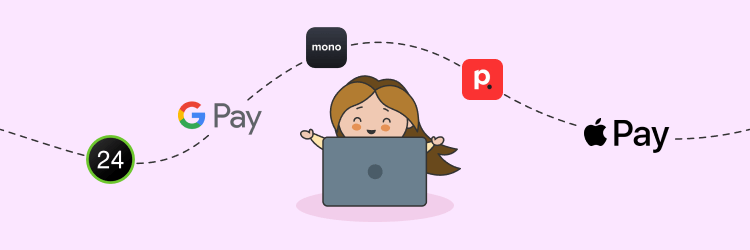Modern retail is becoming increasingly cashless. According to the National Bank of Ukraine, in 2024, non-cash payments accounted for 94% of all bank card transactions. Digital tools make paying for goods convenient and secure.
In particular, payment systems are the most convenient way to pay in online stores. We will discuss how they work and what benefits they offer to entrepreneurs in this article.
What is a payment system?
Electronic payments or acquiring involve many participants:
- a payment provider (payment services such as Rozetka Pay, Fondy, etc.),
- an acquiring bank (where the seller holds an account),
- an issuing bank (whose card the buyer uses to pay for the goods),
- government authorities (the National Bank of Ukraine), etc.
In the course of payment, the participants exchange data according to the rules set forth in the applicable laws and agreements.
Payments are accepted on the website in the following sequence:
- The customer places an order on the website or in the online store’s app and clicks the “Pay” button.
- The website redirects the customer to the payment page, where they need to enter their bank card details.
- The details, payment amount, and transaction code are sent to the payment provider’s server. It sends an authorization request to the acquiring bank.
- The acquirer contacts the payment system to which the card is linked (Visa, Master Card, PROSTIR, etc.).
- The payment system exchanges data with the issuing bank to check the possibility of payment.
- The issuing bank sends a confirmation to the payment system and then to the acquiring bank and payment provider.
- The payment provider sends a withdrawal request to the acquiring bank and then to the payment system and the issuing bank.
- The bank debits the required amount and confirms the payment.
- Confirmation follows the chain: payment system — acquirer — payment provider.
- The provider notifies the website that the payment was successful.
In the complex of technical solutions used in online payment, the payment system is an element that coordinates the work of all other links. It helps to transfer funds quickly and safely without issuing cards to customers, setting tariffs, blocking funds in case of violations, etc.
Today, the most common payment systems in the world are Master Card, Visa, American Express, and others. With the advent of digital currencies, the so-called second-generation payment systems (PayPal, Webmoney Transfer, etc.) have emerged.
Types of payment systems for a website
There are several main types of payment systems that a merchant can connect to an online store website. Let’s take a closer look at them.
Payment gateways
A service that provides data transfer between the website and banks for payment for goods. The payment gateway integrates with the online store via API.
| Advantages | Disadvantages |
|
|
Examples: Way for Pay, LiqPay.
Payment aggregators
Software solutions that combine different payment methods: bank cards, e-wallets, mobile payments, etc. Unlike payment gateways, funds are first transferred to the aggregator’s account and then to the seller.
| Advantages | Disadvantages |
|
|
Examples: Rozetka Pay, Portmone, Easy Pay.
Electronic wallets
Services that allow customers to store funds online and pay for goods in online stores.
| Advantages | Disadvantages |
|
|
Examples: Google Pay, Apple Pay, Privat 24, Monobank
Payment systems in Ukraine
Payment systems in Ukraine are regulated by the National Bank of Ukraine. It grants licenses to payment systems and enters them into the Register of Payment Infrastructure.
According to the current regulations, customers can pay for goods with Visa and Master Card. The Ukrainian payment system PROSTIR has also been operating since 2016, and all domestic banks support transactions with its cards.
Ukraine has both national and international payment systems. The latter work with banks and payment providers from around the world. International payment systems greatly expand the possibilities of paying for goods in online stores.
How to choose a payment system for a website
When choosing a payment system for a website, merchants should take into account its capabilities and the needs of their business. In particular, you should pay attention to the following factors.
- Payment methods. The more payment methods the system provides, the more convenient it is for customers to make payments. Modern electronic payment systems allow you to use bank cards, transfers, e-wallets, etc.
- Commissions. Each payment system charges different fees. Entrepreneurs should take them into account to predict the profit from the online store.
- Withdrawal conditions. To make a profit, the seller must not only provide customers with convenient payment, but also be able to withdraw funds. Withdrawal conditions differ from country to country and from payment system to payment system.
- Legal requirements. To connect a payment system to the website, the seller must conclude an agreement with the provider. The terms and conditions and the list of required documents are usually published on the provider’s website.
- Technical requirements. Most payment systems offer ready-made integration modules or APIs for websites developed on popular CMS platforms (WordPress, Shopify, OpenCart, etc.).
Additional features of the payment system. In addition to fast money transfers, modern payment systems allow you to set up auto-payments, refunds to customers in case of refusal, etc.
For sellers, it is also important to be able to make payments in accordance with all the requirements of tax law. In particular, online stores are connected to software-based cash registers to fiscalize payments and issue receipts for goods to customers.
Acceptance of online payments with Vchasno.Kasa cash register
According to the Law No.265/95, a seller who accepts payments through payment systems must issue fiscal receipts to customers. For this purpose, online stores use software-based cash registers.
Software-based cash registers are convenient for online stores that deliver goods in any way (by postal service, courier, or pickup). The seller sends the customer an electronic receipt by e-mail or messenger. If the electronic format is not suitable for the customer, the receipt can be printed and sent together with the goods.
Vchasno offers a software-based cash register for online stores that work with various payment services and accept different payment methods. Software cash registers are also convenient for trading on marketplaces (Prom, Rozetka, Epicenter). Ready-made integrations for marketplaces allow you to connect a cash register to an online store in a matter of minutes.

Owners of online stores running on Prom and Rozetka can set up automatic receipt issuance. As soon as the order is in the “Done” status, the service will automatically generate a receipt and send it to the customer.
Want to Optimize Payment Acceptance Process at Your Online Store?
Choose convenient integration with the "Vchasno.Kasa" software cash register for your website






